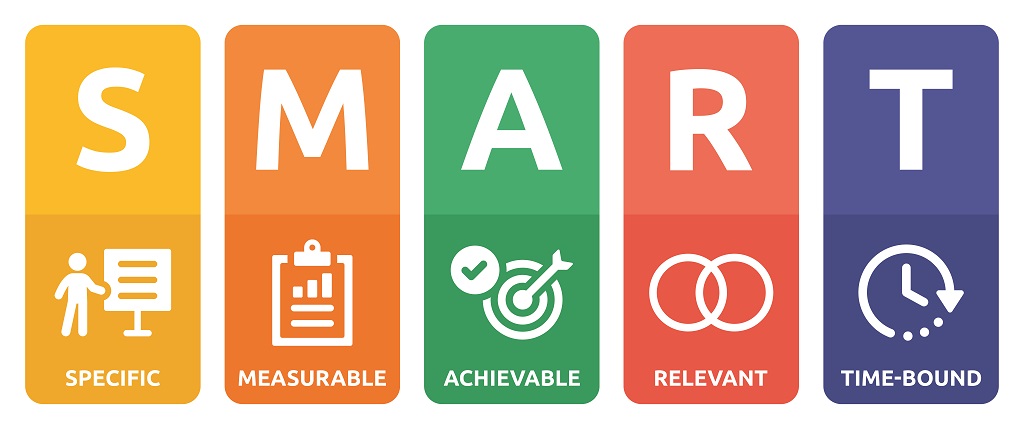Do you ever wonder how some people succeed at everything? The answer is simple; they set SMART targets or goals and work towards achieving them.
A s.m.a.r.t goal turns a vague idea into an actionable, results-oriented plan. A quick example: As business owners, we all want to “get more business,” but to do so, we need to set quantifiable goals that are measurable and easy to track.
For that reason, “get more business” isn’t a SMART goal but “increase revenue by 20% in 6 months is.”
If you don’t already have a clear vision strategy or feel yours is outdated, it might be time to take another look. Our performance improvement consultants can help.
In the meantime, let’s look at what SMART goals are and how they can benefit your business.
What Are SMART Goals in Business?

SMART goals are a framework used for setting and achieving goals in a structured and effective manner. Believed to have originated in the business management industry in the 1980s, the SMART framework makes planning, tracking progress, and achieving your objectives easy.
Specific
When setting goals, you must be specific about what you are trying to accomplish. Distinct and simple objectives erase ambiguity and establish a clear direction. Specific objectives are easy to follow – you can draw a straight line from where you are now to where you want to end up.
Measurable
Identify the metrics you want to use to track your goal. When you include precise amounts, dates, etc., your goal becomes more tangible and allows you to measure progress.
If your goal is merely to “reduce expenses,” how will you know when you’ve been successful? Connecting metrics to your goals helps you measure success and celebrate small wins along the way.
Attainable
Insurmountable goals discourage, but achievable smart goals motivate. To ensure you’re not setting yourself up for failure, consider how to accomplish the goal and if you have the tools/skills needed. If not, what would it take to attain those skills? Move forward from there.
Relevant
Goals should be relevant to your overall objectives. This seems obvious, but often, we work towards goals that don’t move the needle closer to our vision. By keeping goals aligned with your vision, you’ll stay focused enough to move the needle vs. spending time working on something that only distracts from your end destination.
Time-Based
Your goals must have a deadline—we cannot stress this enough. Open-ended goals lack a sense of urgency. If you’re working on a long-term goal, break it into smaller chunks that feel more achievable within a specific time frame.

Let Cultivate Advisors help you create SMART business goals with trackable metrics and succeed.
Schedule Revenue Management Advising SessionThe Benefits of SMART Goals for Business
From improved resource management to innovation and focus, here are the benefits of SMART goal setting:
Clarity and Focus
Achieving your goals is often challenging – distractions, adjacent tasks, and other projects can stop you from accomplishing your objectives. The specificity of your own SMART goals ensures your efforts are channeled into well-defined targets, while their measurability lets you gauge progress objectively, fostering a sense of accomplishment.
Proper Resource Management
Efficient resource management curtails expenses, optimizes processes and amplifies productivity. Enter SMART goals — a formidable asset. Their framework provides a streamlined perspective, enabling teams to pinpoint bottlenecks and obstacles within processes. This facilitates an improved comprehension of when priorities and resource allocation become misaligned.
Motivation Boost
According to McKinsey, “Goal-setting can help improve employee engagement in a way which elevates performance and benefits organizations overall.”
Research by Professor Gary P. Latham found there is an interconnection between positive psychology and goal-setting. Having the right goals builds self-efficacy and creates a sense of mastery over internal and external environments.
Transparency
Good goal-setting promotes transparency by defining clear expectations, encouraging open communication, and fostering shared accountability. It enables regular progress tracking, feedback loops, and inclusive participation, creating a documented record of objectives and outcomes.
This approach ensures that everyone understands their responsibilities, communicates openly, and contributes to the achievement of goals. When individuals or teams are held accountable for specific goals, they are more likely to provide updates and reports.
Effective Communication
SMART goals provide a common understanding of what you’re trying to achieve. If everyone understands the overall objectives, they can better align their work to meet them. This ensures your team works towards the same thing, eliminating duplicate efforts and silo working environments. Additionally, it’s easier to collaborate when everyone is working towards the same objective.
Creativity
Because SMART goals are specific and focused, they nurture constraint-driven innovation. More often than not, constraints imposed by narrow objectives stimulate creative thinking. Limitations tend to encourage unconventional approaches and alternative solutions.
For example, the Apollo program forced NASA to produce lightweight materials, compact designs, and efficient power management systems, culminating in successful moon landings.
Performance
SMART goals empower managers with an effective structure to enhance employee performance and track advancement toward objectives. They improve performance by highlighting strengths and areas for improvement and help individuals and teams gain momentum.
But, more than that, when individual work is directly linked to business priorities, employees tend to be more effective. Why? Because they can see how their work fits into the bigger picture. This immediately encourages better performance.
How to Create Smart Goals for Business

Now that you understand the framework, it’s time to start creating SMART goals.
Take your current goals and walk through these questions to ensure you’re smart about goal setting. It’s a good idea to write SMART goals down.
Initial goal – ____________________
S – Specific – What do you want to accomplish?
M – Measurable – How can you measure progress and know when you accomplish your goals?
A – Achievable – Do you have the skills or resources required to achieve this goal?
R – Relevant – Does this goal align with your overall objectives/vision?
T – Time-based – What is the deadline (and is it realistic)?
During the process of defining your goals and working toward them, you should also:
- Get feedback: Talk to your team, colleagues, or advisors for input. This ensures your goals are realistic and achievable.
- Break goals down: Dividing your goals into smaller steps makes it easier to stay on track and progress toward your objectives.
- Celebrate successes: As you achieve your goals, celebrate the smaller milestones. This will help you stay motivated to continue working towards your goals.
SMART Business Goals Examples
We’ve outlined some SMART business goal examples to understand better how you should approach setting these goals.
Here’s what SMART goals in business look like:
Example 1: Pay Off $10,000 in Business Debt within 24 Months
One of your SMART goals may be to pay off your company’s debt which will allow you to make more money to allocate to other areas of the business.
- Specific: Pay off $10,000.
- Measurable:How will you track the progress you make each month? You can determine this by monitoring your accounts’ cash in and out.
- Achievable: By spending less on growth-oriented goals, we will work alongside our vendors and encourage them to pay on time and in full.
- Relevant: We’ll call attention to the development and project opportunities as the year goes on that will benefit from additional funds after the debt is paid off.
- Time-bound: Within 24 months, you’ll achieve this objective.
Example 2: Increase Website Traffic by 25% by December 2023

Your website plays a massive role in your overall conversion rates and helps to solidify your company in the marketplace. By increasing your traffic, your sales will increase as long as your conversion rate remains as consistent as possible.
- Specific:Increase the number of website visitors by 25%.
- Measurable: Increase the annual visitor total from 100,000 to 125,000.
- Achievable: The inbound marketing team has refined its social media and content creation strategies. We can hire more experts to increase visibility and drive traffic if necessary.
- Relevant:By gaining more website traffic, we’ll be able to reach more customers and make more money.
- Time-bound: We want to achieve this goal by December 2023.
Example 3: Increase New Customer Reviews by 25% Year Over Year
Many companies attribute part of their growth to increased brand awareness and market share. It’s imperative to compile customer reviews to help increase trust and desirability around your company. In the case of this SMART goal example, the company wants to see a 25% increase in customer reviews on a year-over-year basis.
- Specific:Increase new customer reviews by 25%.
- Measurable: Measurable progress through monthly reporting that represents whether or not we’ve hit our target.
- Achievable:Last year, we increased customer reviews by 15%, so this year’s 25% target is possible.
- Relevant: Our research shows that an uptick in customer reviews corresponds to additional sales in our top growth channels.
- Time-bound: This goal is a year-over-year comparison.
Example 4: Increase Average Video Views on Social Media by 25%
According to Cielo24, people spend almost 2.5 hours on social media daily, and 72% favor videos over other types of content. Hence, many businesses invest in social media content to grow brand awareness. You know video is a good content marketing medium, but to leverage its full power, you need SMART goals.
- Specific: Increase average social media views by 25%
- Measurable: Our marketing team will use analytics tools to monitor our views. We can use the data gathered to tweak campaigns.
- Achievable: In the past six months, we’ve experienced a 20% increase, so an extra 5% seems within reach.
- Relevant: Our research shows that videos are popular among our target audience.
- Time-bound: We should achieve this goal within the next six months.
Example 5: Promote Webinar Sign Up by 15%
Webinars are strategic marketing tools that allow businesses to establish expertise, foster new connections, generate leads, and provide valuable content. Improving sign-up rates means more leads to nudge through the sales funnel.
Specific: Increase the number of sign-ups for our Youtube webinar by 14% by promoting it via email, our blog, and other social media channels.
- Measurable: We’ll know how many people have signed up by counting the emails we’ve sent with the watchable link.
- Attainable: Our last webinar saw a 10% increase, so this seems feasible with the right strategy.
- Relevant: The more people attend our webinars, the more sales opportunities we create.
- Time-Bound: By November 15th, the day of the webinar.
Example 6: Boost the Number of Email Blog Subscribers by 50%
For every $1 spent on email, you can expect a $44 return. For marketers, email marketing is a conversion gold mine. If you haven’t already invested in SMART marketing goals, now is the time!
- Specific: We want to boost email subscribers by increasing our X (formerly Twitter) advertising budget on blog posts that have received the most email subscribers.
- Measurable: Our goal is a 30% increase in subscribers.
- Attainable: Since we started using this tactic three months ago, our subscribers have grown by 20%.
- Relevant: More subscribers mean more leads, giving us a chance to sell more products and build awareness and brand loyalty.
- Time-Bound: We hope to achieve this in one month.
Example 7: Increase New Customer Reviews by 35% by the End of the Year
Business expansion is closely tied to your business’s recognition within the market. Therefore, a significant objective in nurturing your brand involves enhancing its visibility throughout the year.
- Specific: Increase customer reviews by 35%.
- Measurable: We measure our progress through monthly reporting and reading our reviews on various platforms.
- Achievable: We increased our customer reviews last year by 25%. A 10% increase is well within our reach.
- Relevant: Our sales team tells us positive reviews correlate with increased sales.
- Time-bound: This is a YoY comparison.
Final Thoughts
If you want to be smart in business, you need SMART goals. If you require help figuring out where to start with your SMART goal framework, you don’t have to go at it alone. Schedule a complimentary 2-hour session with our Cultivate Advisors.
We’ll dig into your business to uncover bottlenecks and develop a roadmap based on where you are in your business and where you would like to be. With this information, you’ll have a tangible plan to implement to reach your long-term goals.




